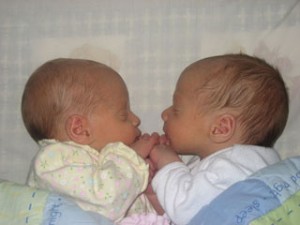Two years ago, Tricia Shanks lay stoic atop her doctor’s table and held her breath while waiting for him to deliver the news. Having already endured a miscarriage, the 28-year-old from Indianapolis, Ind., did not want to be told a second time that artificial insemination had failed.
But Shanks and her husband Pat were well versed in fertility treatment success rates — a baby could never be guaranteed. So they braced themselves for the worst while the doctor stared at the ultrasound for a protracted amount of time, and motioned to the nurse to bring him Shanks’s file. He was silent.
“Oh, no,” Shanks murmured to herself. “He doesn’t see a heartbeat.” But as the doctor slowly rotated the screen towards the anxious couple, they understood his unsettled reaction.
Shanks was right; her doctor didn’t see a heartbeat. He saw three.
Discovering you are pregnant with triplets or more is becoming increasingly unlikely as U.S. fertility clinics, responding to government pressure, are reducing the amount of high-order multiple pregnancies induced by drugs or by treatments such as in vitro fertilization.
Spurred by stories such as that of Nadya Suleman, the California single mom whose octuplets in January brought her total of IVF babies to 14, organizations such as the American Society for Reproductive Medicine are calling on doctors to transfer no more than two embryos per cycle during treatment. The stricter guidelines, which doctors are not yet legally bound to follow, are working, according to the ASRM. Today, less than 2 percent of all live births are triplets or greater, a number down from 6 percent in 2003. And while 62 percent of IVF treatments used to involve the transfer of four or more embryos in 1996, 11 percent of fertility clinics now report they use only one embryo.
Doctors claim the motivation to prevent these pregnancies is not because a set of three or four or even eight are unlovable, but because the health risks for both mother and children are much more severe. Still, plenty of women like Shanks continue to defy the odds and rear multiples despite the lack of sleep and the exorbitant grocery bills. The work is exhausting, she says, but the rewards are triple-fold.
“I feel like I am almost home free,” said Shanks, now 30, who spoke on the phone while 18-month-old Stella, Morah and Ryan were napping. “These are an exceptionally hard two years, but it’s getting easier. I love watching them learn from each other.” And, she added, it must be so special for them to have constant playmates from the time they were born.
Even though they used fertility treatment, Shanks admitted that she and her husband were shocked to learn that they were expecting three babies instead of one. They didn’t speak for an hour after leaving the doctor’s office, both consumed with the list of things they needed to do to make room for their expanding family. Buy a bigger car. Buy a bigger house. Find a three-person stroller.
“It was crazy,” Shanks recalled. “We were not set up for this.”
Certainly, the financial burden of providing for trips, quads or quints is one of the greatest challenges that parents of high-order multiples face. Many couples who have difficulty conceiving have already invested thousands of dollars in fertility treatment by the time they learn that they’re pregnant — the average cost of one cycle of IVF in the U.S. is about $10,000. Add to that the mountains of diapers and 18 daily jars of Gerber food during their children’s babyhood, nevermind paying three or four times more than the average parent does for college tuition. But the one thing multiples’ moms and dads really can’t afford to skimp out on is childcare.
“If I had to do it all over again, I would hire someone for at least three days a week,” said Shanks, who manages her toddlers almost entirely by herself while her husband is at work. “If we couldn’t afford it, we would take out a home equity loan or something, because the extra person is worth the expense.”
Leslie Kirby, a triplet mom from Darien, Conn., agrees. At age 11, her set of three is well beyond the diaper years, which 47-year-old Kirby can remember only as “a blur.” But with another daughter in high school in addition to her threesome, she still has her hands full. That is why she still employs her live-in nanny, who has been with their family since Lindsey, Chandler and Jake were just a month old.
“At 3:00 p.m., after school, we start driving everyone around,” explained Kirby of how she and her nanny execute the routine. “Everyone has sports or piano lessons or some sort of activity.”
Kirby doesn’t consider herself as a multiples’ mom as much as she does a mother of four,. A lot has changed since the early days when the most she and her husband could muster for their triplets was zone defense instead of man-to-man. But that’s not to say it isn’t stressful anymore.
“Bigger kids create bigger problems,” she said. “When they are little, it is about meeting their survival needs: feeding and changing and sleeping. Now I am asking if their homework is done, if they are in the right classes, if they’re happy.”
Both Kirby and Shanks were fortunate to have relatively smooth pregnancies, despite the fact that carrying triplets, particularly triplets that occur with the help of drugs or treatment, increases your risk for experiencing complications such as premature labor, premature birth and pre-eclampsia, a condition marked by high blood pressure and protein in the urine that can lead to seizures harmful both to mother and infants.
“The higher number of fetuses, the higher the risk,” said Dr. Louise Tomm, an OBGYN who works in the delivery ward of Duke University Hospital in Durham, N.C. In the past year, she has helped deliver three sets of IVF triplets, whose labors were more difficult compared to the two sets of spontaneous trips she came across.
“High order multiples almost never go to term,” she added.
This was the case for Manhattanite Laura Doyle, who delivered her triplet girls six and a half weeks early after a very taxing pregnancy in which she suffered a blood clot in her lung as well as a worrying liver condition which convinced her doctors to induce her labor.
“I am just thankful that all my kids are healthy,” said Doyle, whose daughters are now four. “That is the huge reward that you really appreciate after you go through a horrible pregnancy. There are a million other stories that don’t end as happy.”
It is these stories that concern health officials who are pushing for tighter legislation on fertility medicine. Sean Tipton, a spokesperson for the American Society for Reproductive Medicine, is pleased that that the rates of high order multiples is finally starting to decrease after the ASRM decreased their recommended number of embryos to be transferred during IVF treatment for the fourth time in ten years.
“We advocate trying to drive towards singleton pregnancies,” he said in a recent phone interview, citing serious health risks such as developmental delays, blindness and prematurity as reasons to prevent the occurrence of high-order multiples. While many patients have to be discouraged from seeking twins, he said, most people don’t seek triplets.
And, Tipton added, doctors should discuss the option of fetal reduction with the patient.
Fetal reduction is when one or more fetuses are terminated in a multiple pregnancy to increase the chances of carrying the remaining babies to term safely, with minimal risk to the mother and children. When Kirby and her husband were advised to consider all of their options, they visited a reduction specialist in Manhattan. They decided against it.
“We were shown this film where a fetus was injected with potassium chloride and I couldn’t sit through it,” she recalled. “At the end of the day, we would not do that.”
Many organizations that promote raising multiples are avid critics of fetal reduction practice. Maureen Boyle, a mother of five, founded Mothers of Super Twins (MOST) shortly after her triplets were born in August of 1987—before three-person strollers were available in the U.S.
The group now reaches out to 20,000 families who are seeking advice on everything from how to cook for an army of kids to how to cope with post-partum depression, another health risk that is more common in high-order multiple pregnancies. Boyle knows full well how stressful it is to parent a large brood, but she maintains that terminating a multiple pregnancy is not a solution.
“You just could not possibly imagine you could love these babies as much as you do,” said Boyle over the phone from her office in East Islip, N.Y. “You have your hands full with three or four or five babies, but you can not imagine your life without anyone of them.”
Boyle acknowledges that the challenges that face these couples can be overwhelming. Not only do moms of multiples report a greater incidence of post-partum depression (43% higher than singleton moms, according to the Pediatrics Journal), but the time-consuming nature of rearing so many babies at once frequently strains the relationships they have with their partners.
“For a good year of your life, your husband is going to be more of a co-worker or a friend than an intimate partner,” she warned.
Those who have a high-risk pregnancy are prohibited from having intercourse halfway through their second trimester. And after the babies are born, you’ll be too exhausted to make time for each other. Despite these early struggles, Boyle insists that there is nothing quite like the feeling of three sets of feet kicking inside you, or of nurturing a bond between your kids that ordinary siblings can not experience.
Doyle, Shanks and Kirby all agree. Their kids are incredibly close, they say, and it is a privilege to bear witness to it.
“You can see their personalities emerge much more quickly since you have a point of comparison,” said Doyle, adding that she was even disappointed that her girls did not engage in the “multiple secret language” she had heard so much about.
Kirby cautions expecting parents of multiples to take it one day at a time, but to have fun with it as well.
“I couldn’t ask for anything more of my life,” she said. “At the end of the day, it’s the most rewarding thing.”
And fortunately for new moms, she has never seen anyone who couldn’t handle the stress.
Victor Furtick, a nineteen year old from Baychester, N.Y. can attest to the unusually strong camaraderie that exists between multiples. He and his three identical brothers, better known as the Furtick Quadruplets, grew up in the limelight after their birth made headlines in 1990.
Their mother, Brenda, who did not plan on having any more children after losing her teenager to gang violence, had not undergone any fertility treatment when she discovered she was pregnant with four—a spontaneous pregnancy that stands a one in an eleven million chance of occurring. Defying such odds proved lucrative for the Furticks, who were frequent guests of Jay Leno and Diane Sawyer as well as commercial stars for Wendy’s and Tide.
Victor remembers him and his brothers being mobbed on the first day of middle school by a crowd of adoring peers.
“It was like we were celebrities,” he recalled. He and his brothers had a secret language that occasionally drove their parents crazy. Admittedly, it wasn’t always easy for Victor to forge his own path as one of such a famous foursome, who always shared a classroom with another brother. Often, all four of them had to dress alike to emphasize their identical appearance.
“I didn’t have a sense of individuality,” he said.
But Victor and his brothers have since stolen glimpses at self-discovery now that they all attend different colleges. The four brothers talk about three times a week on the phone, and are anxious to reunite this summer. None of them would have wanted a different childhood.
“I think you have to milk it for all its worth,” he advised. “You shouldn’t try and separate from each other, because you’re a miracle. So be proud and accept it.”



Comments
Greet post this will really help me!
Me together with my husband are expecting our first infant around four months. As a soon to be young mommy I i’m aiming to be able to learn as much as viable. This particular website had been genuinely insightful. I am on the lookout just for fresh guidance all of the time in addition I sincerely like to learn and in addition I read quite a bit. If perhaps you have got any authors or just courses regarding new mothers anyone could possibly suggest I would definitely value any recommendation.
Fascinating blog on Pavement Pieces » Blog Archive » Baby Multiplicity, unlike the others!
I am grateful to have found this site. Keep up the good postings.